Wed, Oct 30th 2024
THE CAKE IS A LIE
I have a plan. On my back, I carry a heavy load: a camera, microphone, Zoom recorder, and tripod. I decided to leave my bike at Amsterdam Sloterdijk train station—a huge mistake. Utrecht’s main station is a maze, and I wander up and down various routes before finally finding a bus that will take me to the first venue: IMPAKT’s Centre for Media Culture. This is where the main exhibit, THE CAKE IS A LIE, is showcased. A small group of people stands outside, smoking a cigarette, but the real fuss is on the second floor of the building. I’m searching for someone in a red suit; this is part of my mission and the reason for the heavy load I’m carrying. I find Mike Bonanno from The Yes Men deep in conversation with one of the curators and the program coordinator of this year’s festival, Daniela Tenenbaum. I grab a glass of white wine and head downstairs to the exhibit. An opening speech is about to begin. Two large velvet theatre-like curtains mark access to the room.
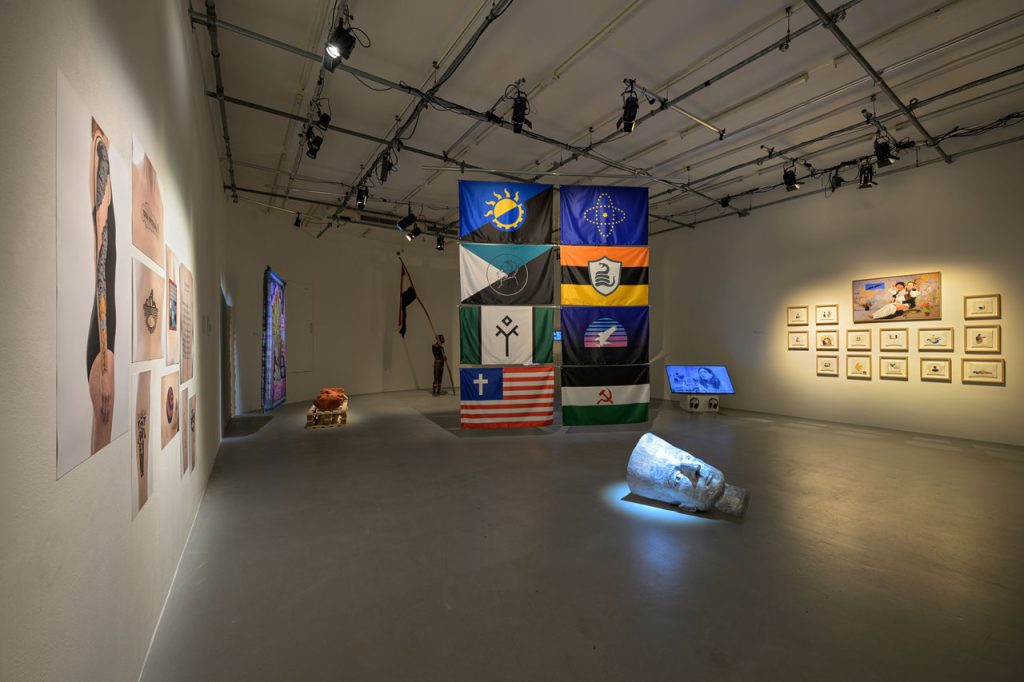
Credits: Pieter Kers – beeld.nu.
Inside, visitors can have a look at the works of this year’s exhibit featured artists: Joshua Citarella, Julie Goslinga, Himmelsbach, Kubra Khademi, Jeroen Jongeleen, Susanne Khalil Yusef, and a collective artwork by Marcos Kueh, Funda Baysal, Ritvik Khushu. Other contributors include Mary Maggic, Joyce Overheul, Roee Rosen, and Roy Villevoye. I circle the entire space a couple of times, making use of the equipment I brought with me by taking some pictures. At one point, the lighting seems to grow softer, and a large group gathers in front of Fraternal Fuck by Kubra Khademi. Ine Gevers and Arjon Dunnewind, the curators of The Cake is a Lie, begin the round of introductions.
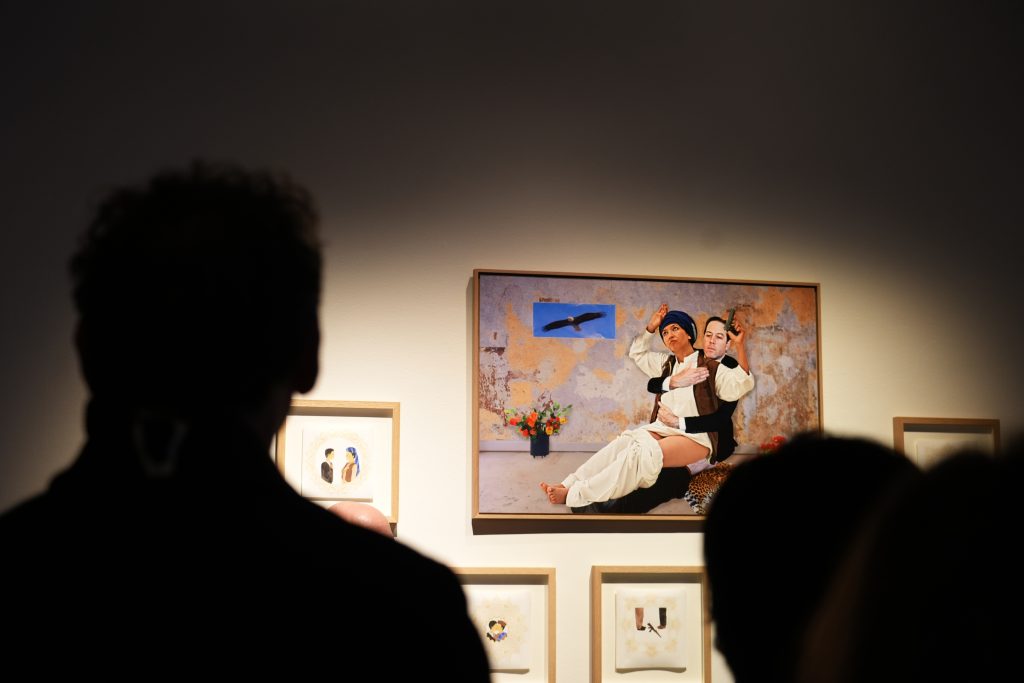
The atmosphere is crowded, and everyone’s curiosity is palpable. The exhibition’s title – The Cake is a Lie – echoes the viral internet phenomenon from the 2007 videogame, Portal. It’s a humorous choice, yet the contrast with the diverse selection of artworks elicits a bittersweet smile from the audience. The persistence of gaming themes in recent cultural events and contemporary investigations intrigues me—especially in times when there seems to be little left to laugh about. This feeling surfaces again when Himmelsbach (Dominique Himmelsbach de Vries), a social designer and the mind behind WILDERSWEBWINKEL.NL, begins to speak. His work takes the form of an ironic shop selling Geert Wilders-themed gadgets—perfect for the holiday season, visiting friends, far-right party supporters, or even that irritating neighbor of yours.
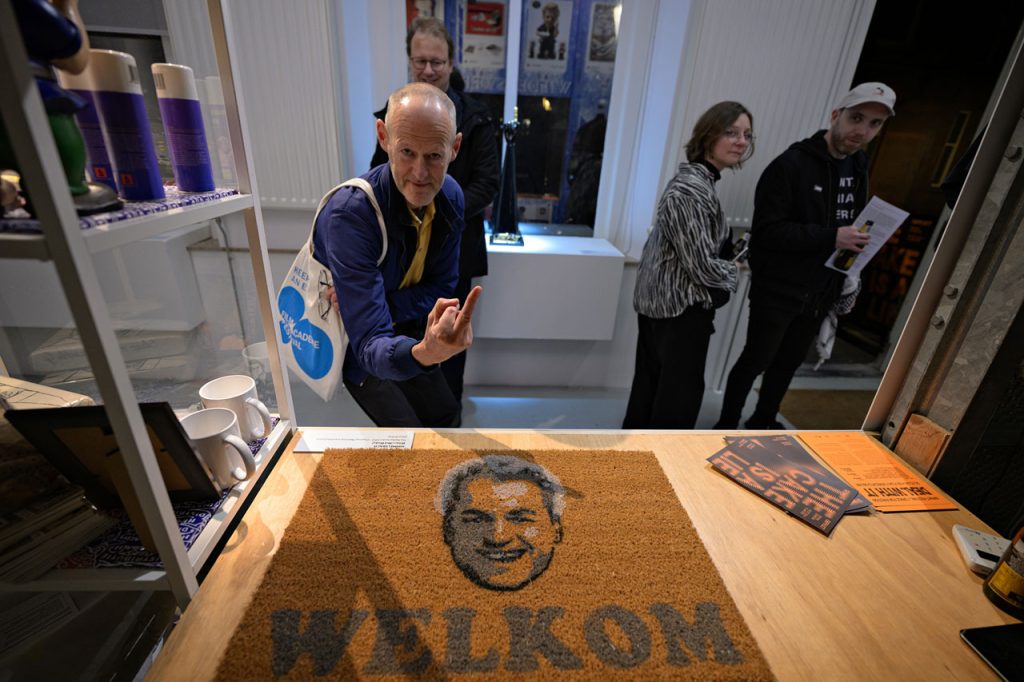
Credits: Pieter Kers – beeld.nu.
From WildersWebWinkel:
“By challenging and disrupting societal polarization, we strive for deeper understanding and connection between divided groups and celebrate the richness of human visions and experiences.”
After Himmelsbach, Roy Villevoye takes the stage, presenting Reset – Vienna 1909, 20-year-old Adolf Hitler Is Homeless (2024), and Amún Mbes’ Reenactment (2017). Following him is Roee Rosen, showcasing The Gaza War Tattoos. Continuing my tour of the room, I stop in front of a three-screen installation displaying a 3D animated video. The alien-like figure on the screen speaks from a bathtub drenched in blood. As they talk, I move closer, peering through the gaps between people’s shoulders to get a better view. The work is titled UNDERSTANDING OTHER(S). The artist is Julie Goslinga, and later on that night, I had a chance to speak with her and record an interview about her process.
DEAL WITH IT
Opening night keynote speech – Het Huis
We all move to Het Huis for the keynote speech that marks the official opening of IMPAKT’s Festival night. The session features Dries Verhoeven, Mary Maggic, and Mike Bonnano (The Yes Men), moderated by Cecile van Bruggen. Alongside curators Ine Gevers and Arjon Dunnewind, van Bruggen introduces new festival participants who had not yet spoken at IMPAKT’s Centre for Media Culture. Dries Verhoeven, a theatre-maker and visual artist based in the Netherlands, presents his performative installation Alles Moet Weg, 2024 (Everything Must Go), which is on display at De Paardenkathedraal from Thursday, October 31st. The work examines the moral landscape of late capitalism from shoplifters’s perspective.
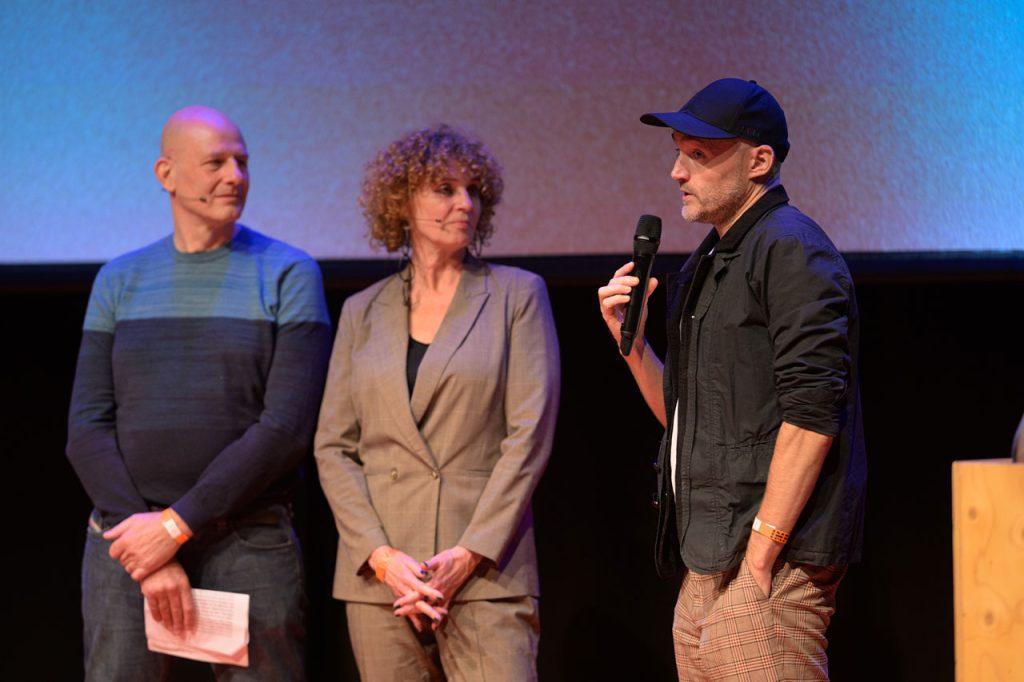
Credits: Pieter Kers – beeld.nu.
Following him, Mary Maggic takes the stage. A nonbinary Chinese-American artist and researcher, Maggic frequently employs biohacking as a xeno-feminist practice of care, aiming to demystify the invisible lines of molecular bio-power. Maggic is also a contributor to the Cyberfeminism Index, exhibiting their work Estroworld-now: The Quarantine Edition (2021) at The Cake is a Lie. In addition, they are also participating in various panels throughout the festival.
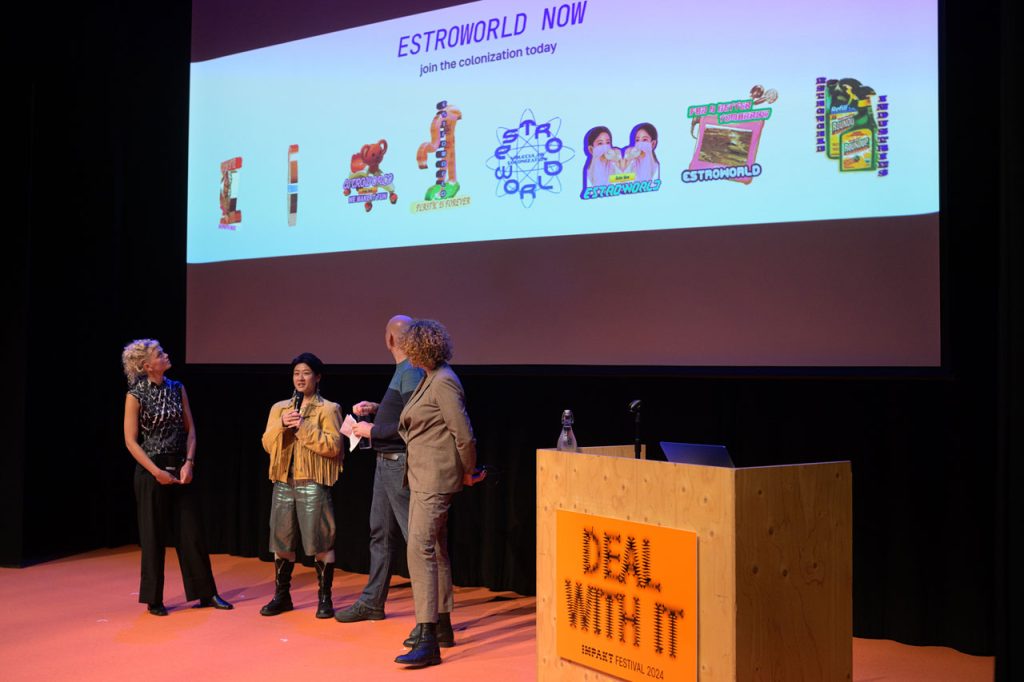
Credits: Pieter Kers – beeld.nu.
Then, the stage clears—just in time for a grand entrance. A green sponge, oozing a slimy green substance, walks in. Holding a microphone, the sponge addresses the audience in a familiar voice. It’s Mike Bonanno, disguised as Scrubby, the greenwashing sponge.
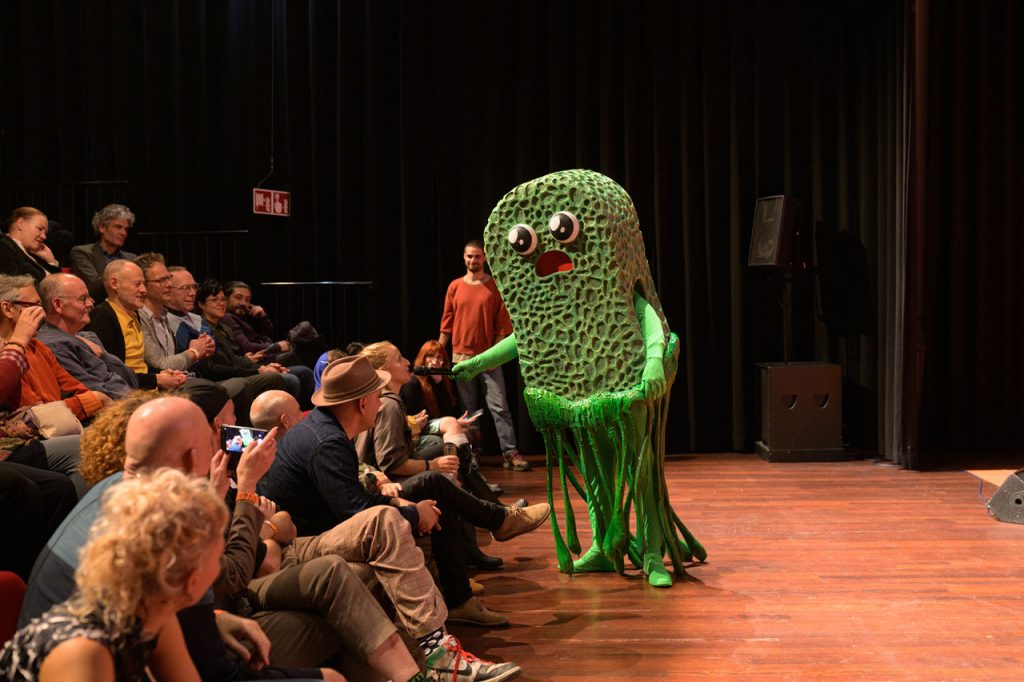
Credits: Pieter Kers – beeld.nu.
When Scrubby approaches the laptop to begin the slide presentation, he finds out that the fabric of his green fingers makes clicking impossible. In one swift motion, Mike Bonanno emerges from beneath the disguise. He begins by introducing The Yes Men’s body of work over the years, recounting its origins and its very first hijacks. After the presentation, he hands out a very-secret-book, which he invites the audience to pass around. While he doesn’t reveal much about the book’s mission, he promises that all will be revealed in early December.
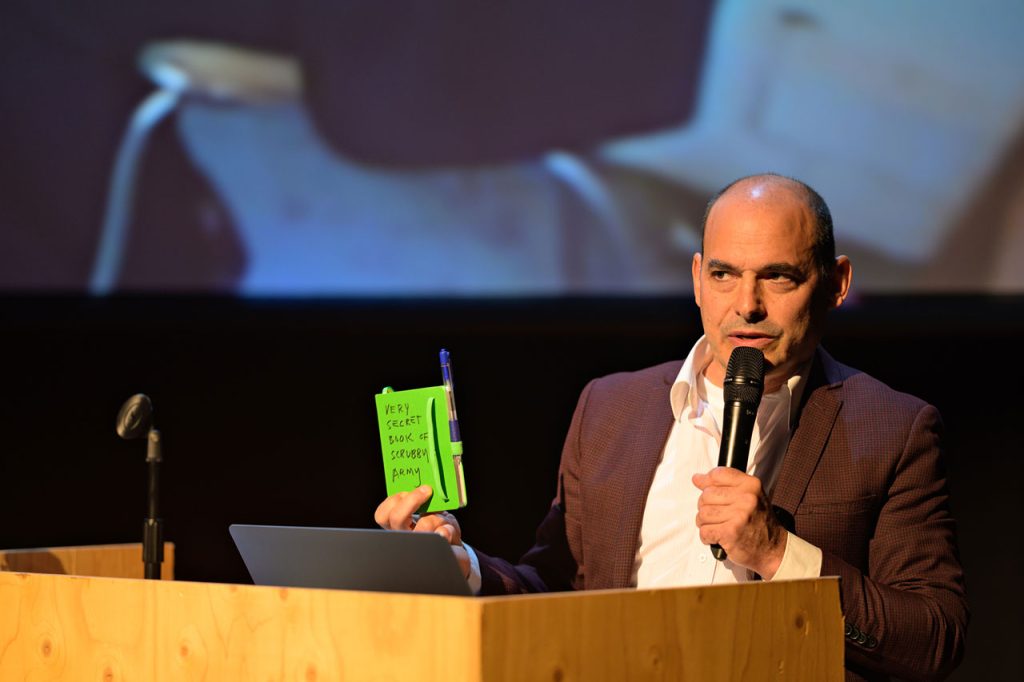
Credits: Pieter Kers – beeld.nu.
The next segment features the first European screening of The Yes Men’s latest documentary, Adidas Owns the Reality (2024). The activist group, Clean Clothes Campaign and Berlin designers Threads and Tits fooled the fashion world into believing Adidas had launched a revolutionary ethical campaign. The movie featured a fake co-CEO, Cambodian garment worker Vay Ya Nak Phoan, who exposed labor abuses and signed a “Pay Your Workers” agreement. The unveiling of “Adidas REALITYWEAR,” a provocative streetwear line reflecting worker exploitation, shocked audiences with its graphic presentation of factory workers’ conditions. After a while, Adidas denied any involvement, but the elaborate spectacle, complete with staged press releases and a campaign official website, highlighted their human rights violations. Activists used the hoax to push the company to take accountability for improving workers’ treatment and sign the binding agreement. Christie Miedema and other members of the CCC are also present in the audience, along with labor organizations and union representatives. During the Q&A session, they take the floor to elaborate on their legal work and their collaboration with The Yes Men on this project. The movie also includes clips from the fashion show staged during the Berlin Fashion Week 2023, showcasing reactions from the largely unsuspecting audience. From The Yes Men strike again: Adidas failure to meet workers’ compensation demands highlighted in adiVerse hoax:
During Berlin Fashion Week in 2023, these same activists released a false statement from Adidas announcing that its new CEO would appoint a former garment worker as co-CEO. This statement included the suggestion that Adidas would move to sign the Pay Your Workers – Respect Labour Rights agreement, legally binding the company to compensate and safeguard workers and their rights.
Later on, I have a chance to speak more with Mike Bonanno and record an interview, including some stolen shots of Scrubby.
Fri, Nov 1st 2024
Reinventing Manhood
I return to Utrecht, feeling a bit more accustomed to commuting. The plan for the day is to attend the first panel, Reinventing Manhood, and later check out Dries Verhoeven’s performance, Alles Moet Weg. At noon, we enter the main stage of Het Huis, where Linda Duits moderates the panel discussion featuring Mounir Samuel, Babah Tarawally, and Mary Maggic.
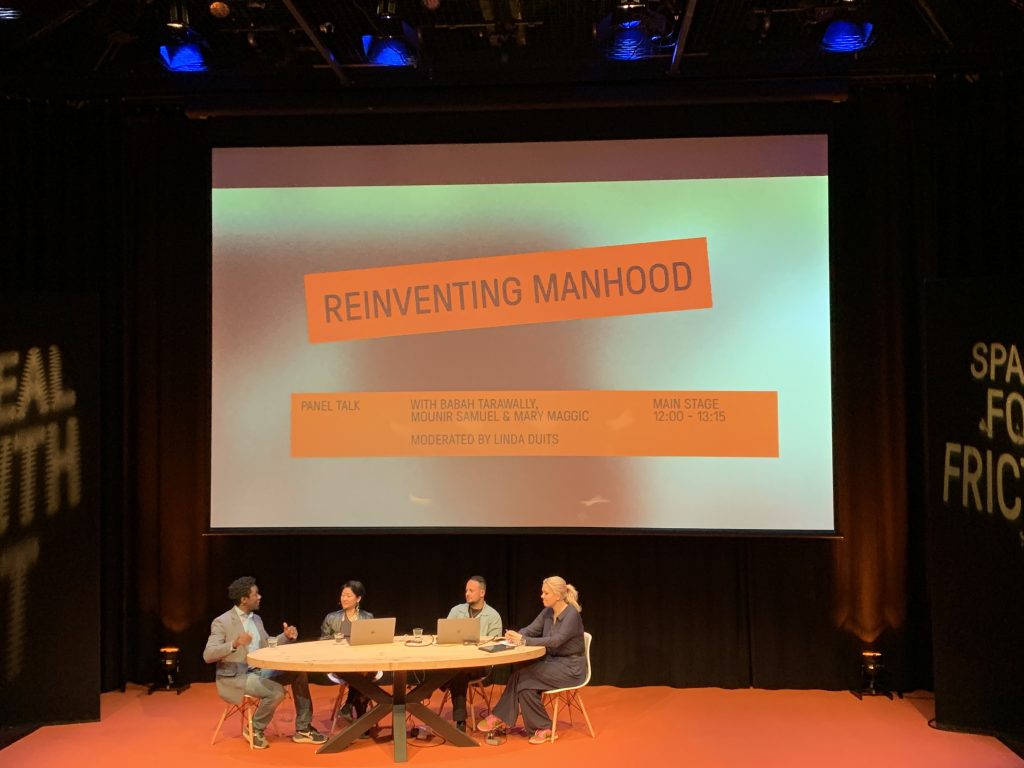
The session begins with an introduction of the speakers, after which Duits hands the floor to multidisciplinary artist and journalist Mounir Samuel. Samuel provides an analysis of gender identities in the Netherlands through the lens of language and biblical translation. He reflects on how northwestern Europe has historically set global standards for gender diversity.
Next is Babah Tarawally, a writer, columnist, and journalist originally from Sierra Leone who came to the Netherlands in the 1990s as an asylum seeker. He discussed his latest book, De Getemde Man (2023), and speaks about how his childhood shaped his understanding of gender. For Tarawally, naming things brings attention to them.
The last speaker, Mary Maggic shares also a personal story, touching on the expectations placed on Chinese women and exploring definitions of gender that aim to liberate rather than confine. Maggic emphasized the violence inherent in rigid gender categories and discussed the importance of limits, permeability, and our connections with environmental change. They also mention the project Open Source Estrogen, which positions biohacking as a form of existential knowledge, exploring the intersection of gender and climate change and highlighting their interconnections. A thought-provoking question was raised about whether queer bodies have a place in the future, given their non-reproductive nature. Additionally, the discussion emphasizes love as a radical strategy to counteract an industry fundamentally built on lovelessness. Finally, the panel addresses the societal framing of menopausal women as obsolete, challenging these perceptions. Maggic speaks about gender manipulation discourses, encouraging us to “love the alien in you“.
CONSENSUS ARCHITECTS INC.
Jonas Lund
After the panel, I grab some lunch. On the second floor, in Studio 2, there’s a performative installation going on: Consensus Architects Inc. by Jonas Lund. I enter the room, and it resembles an office space populated by a few people drinking coffee, working on laptops, and wearing name tags. The person at the desk gives me one, too: I am Aisha. Along with the name tag, I receive a printed page detailing Aisha’s background, mission, conspiracies, and her behavior towards other company members, especially Maxwell, the Head of Misinformation.
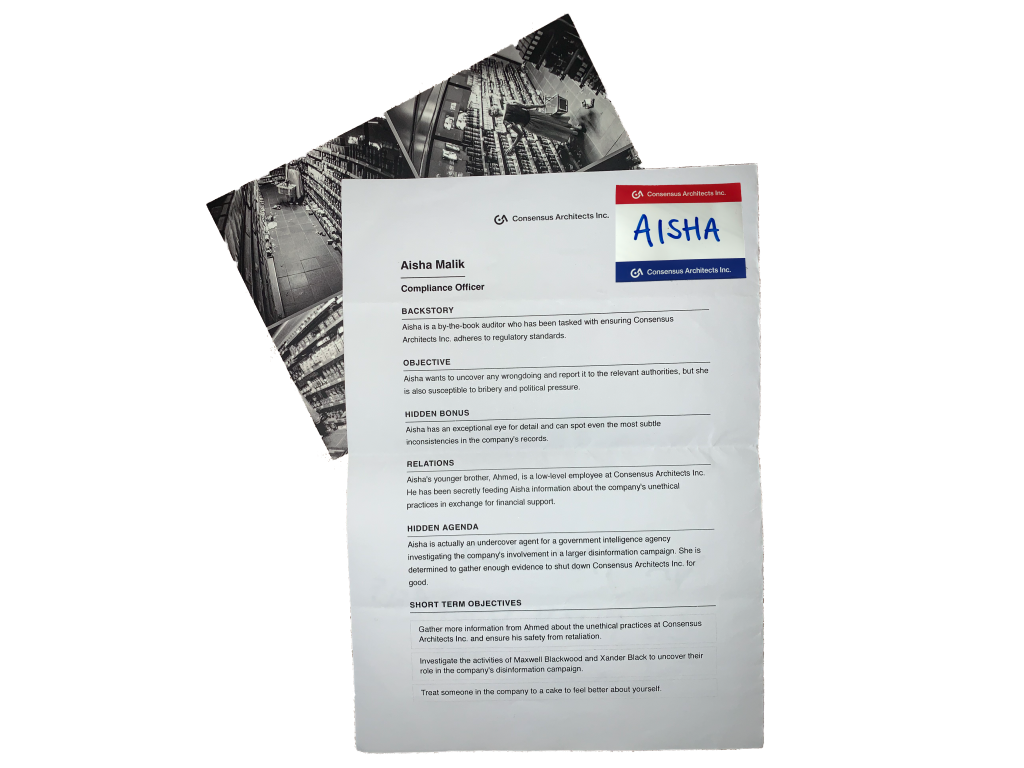
I’m invited to get a drink and begin socializing with the others in the room. Consensus Architects Inc. turns out to be an engaging roleplay experience. Participants take on roles such as political strategists, content creators, or investors in disinformation. The installation critiques misinformation campaigns, highlighting ethical dilemmas, and encourages to reflect on the impact of propaganda and susceptibility manipulation.
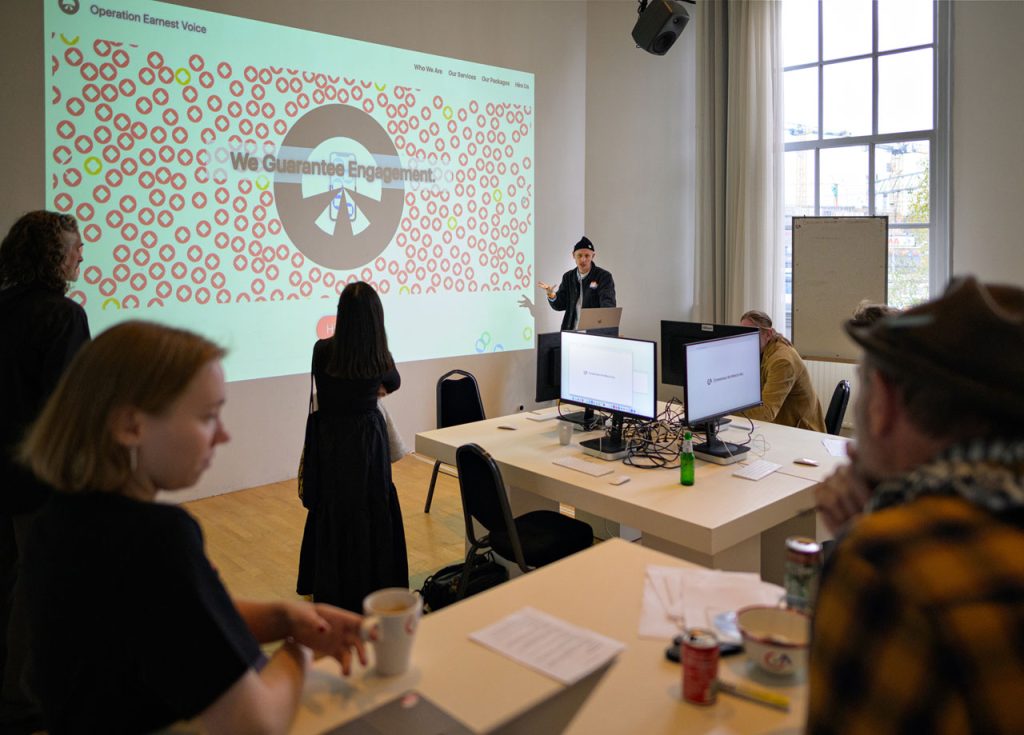
Credits: Pieter Kers – beeld.nu.
The office setting feels like a social experiment, with no client interactions (no showings) and no CEO speeches for this session. It’s all about roleplay, suspension of disbelief, absurdity, playfulness, boundaries, and masks. I find myself amazed by the easiness of getting involved with each character, bonding on the simple fact that all the strangers around me have a clear mission printed out in front of them. Which makes us a little bit less strangers for a couple of hours.
EVERYTHING MUST GO
Dries Verhoeven
After saying goodbye to my newfound colleagues with a clear excuse (I have to take my son from his school’s theatre play), I take a bus to De Paardenkathedraal, to view Dries Verhoeven‘s Alles Moet Weg (Everything Must Go, 2024).
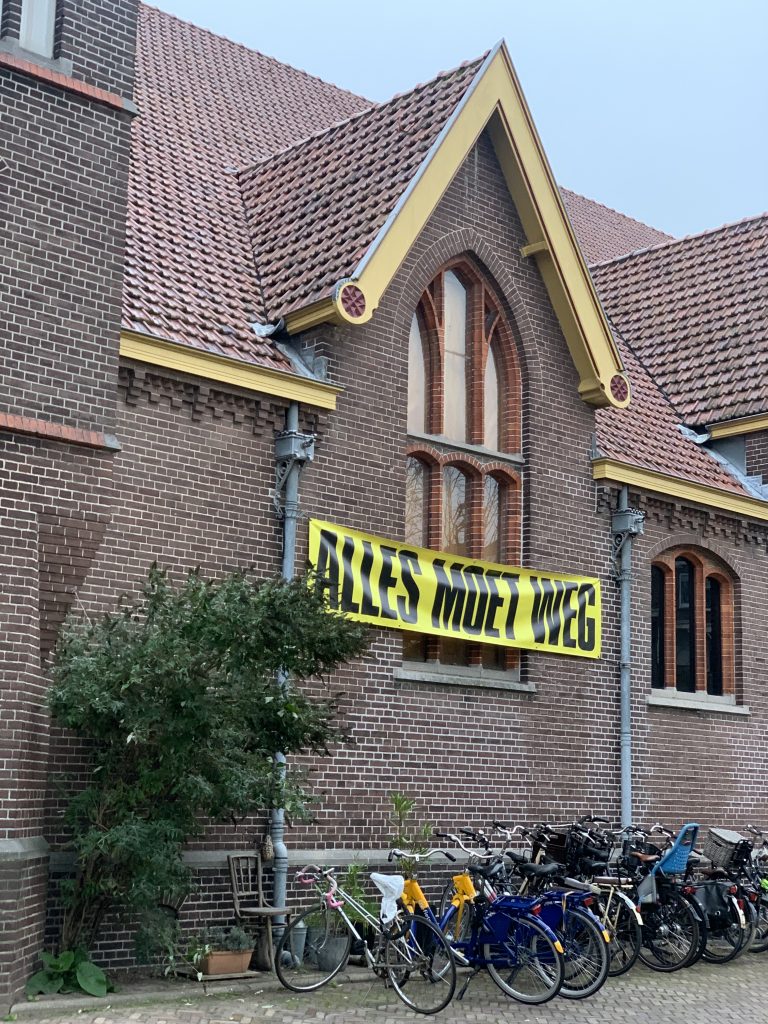
I leave my coat at the entrance, and I step into the exhibit space. The setting is the perfect reproduction of an Albert Heijn’s aisle. A performer with a Snowhite dress and a piggy mask is sucking from a tomato paste. Their voice resonates in the room, dark and quiet, while screens show different angles from CCTVs planted inside the glass-bordered lane.
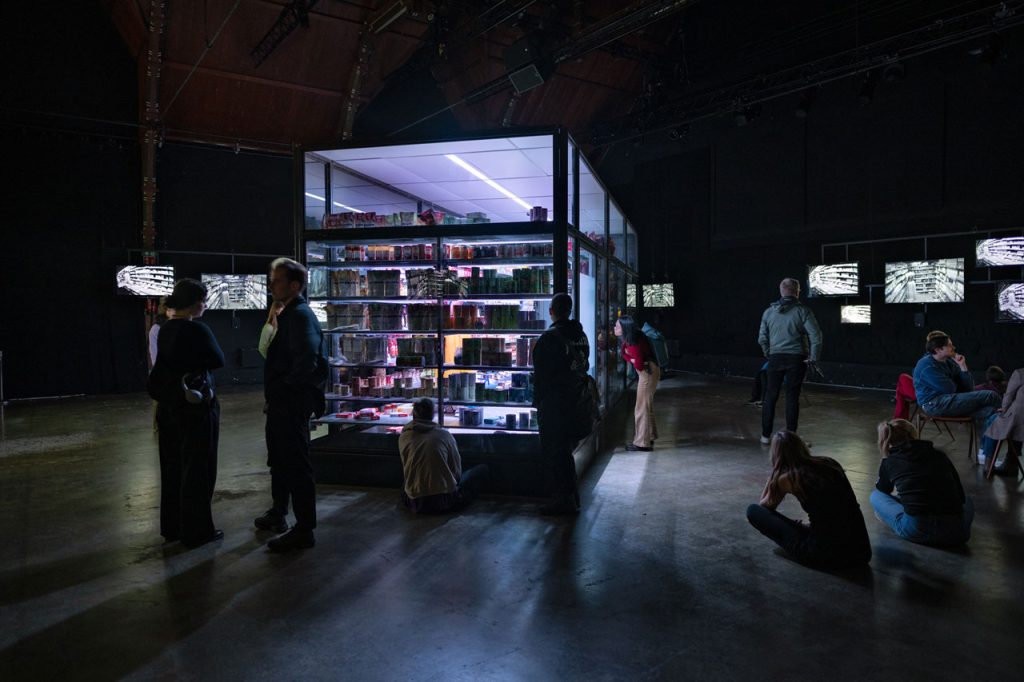
Credits: Pieter Kers – beeld.nu.
For this piece, Verhoeven interviewed 24 supermarket pickpocketers who consider their action a form of resistance to an unjust system. The dialogues that the performer is presenting are crafted from interviews with the late capitalism’s Robin Hoods, combined with excerpts from Jean Genet, Karl Marx, Ruben Östlund, Rachel Shteir, Mathild Clerc-Verhoeven, and Slavoj Žižek’s words.
6.
We have to do this together, people. if we don’t do it, who will do it?
We have to destroy the supermarket from within.
Our shopping cart is
a Trojan horse, you get it?I started sharing online what I take from the store…
and my followers really appreciate it. We become this army of shoplifters… the product liberation front.
And it’s also just a goodjoke of course, stealing. #borrowing
In other words: How to steal?
Lesson one: presentation.
Don’t dress too shabby, no hoodies, no leggings.
And the outfit has to match…
you cannot wear a fancy jacket
from Bijenkorf with worn-out sneakers.Not too much makeup. Lesson two: methodology.
Roughly speaking, there are two methods: be messy or be impeccable.
First, the messy method.
Forget a basket, make sure you have too many groceries in your hands.
Make a call while walking, put your phone back in your pocket, take it out…
put a protein bar in your pocket, take out your phone again, drop something.
In other words: juggle.
The atmosphere is captivating, with a strong mise en scène. There’s an uncomfortable feeling that perfectly represents a common sensation, making it easy to immerse in it. It’s creepy, yet also poetic, as the performer describes it. As the lights shift to a warmer pink, the eyes beneath Piggy’s mask glow, and the camera is suddenly pushed away. You can feel the two dark holes looking into you, even though they aren’t. What are they focused on? An expert shoplifter? An amateur? Are you a messy or an impeccable thief? I find myself wondering: which type am I?

